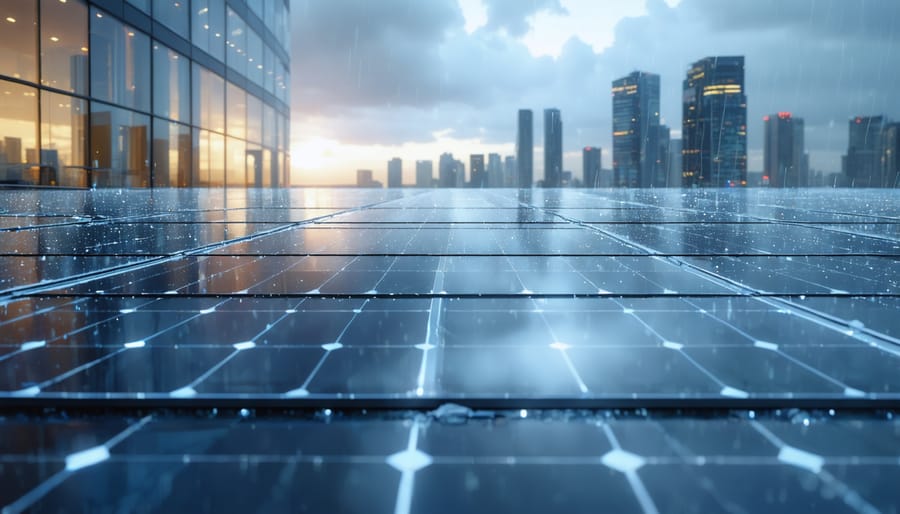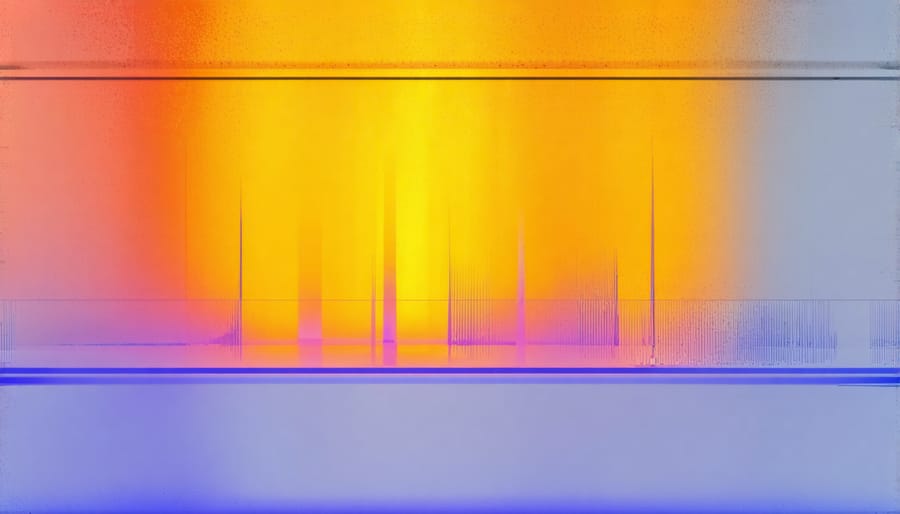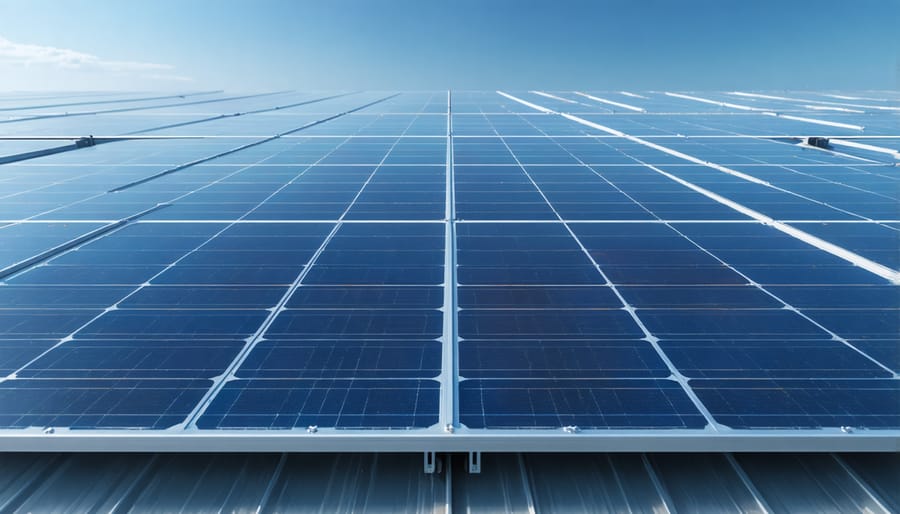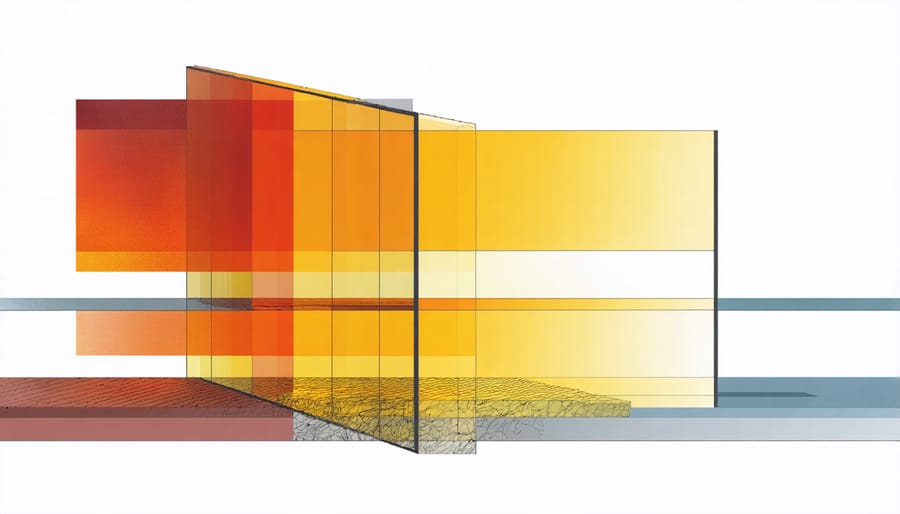Heat-Resistant Glass: The Key to Safer Solar Infrastructure

Glass heat resistance stands at the forefront of modern architectural innovation, where thermal performance meets structural integrity. When exposed to intense heat, specially engineered heat-resistant glass maintains its structural stability up to 800°C, significantly outperforming standard glass which typically weakens at 150°C. This remarkable thermal endurance has revolutionized everything from solar panel installations to fire-resistant building facades across Europe’s diverse climate zones.
Beyond mere temperature tolerance, heat-resistant glass incorporates sophisticated molecular structures and protective coatings that actively regulate thermal transfer. This technology enables dual functionality: protecting building occupants from excessive heat while optimizing solar energy capture for sustainable power generation. As European industries transition towards renewable energy solutions, understanding glass heat resistance becomes crucial for architects, solar installers, and property owners investing in long-term infrastructure development.
The science behind glass heat resistance combines advanced materials engineering with practical application requirements, delivering solutions that meet both safety standards and energy efficiency goals.
Understanding Glass Heat Resistance Fundamentals
Thermal Stress and Glass Behavior
Glass exhibits distinct behavior when exposed to temperature changes, making effective thermal energy management crucial in solar applications. When heated, glass expands uniformly, but problems arise when temperature differences occur across its surface. These thermal gradients create internal stresses that can lead to cracking or breakage if they exceed the material’s structural limits.
The rate of temperature change is particularly significant. Gradual heating allows glass to adapt more effectively, while sudden temperature shifts increase the risk of thermal shock. This behavior is influenced by factors such as glass thickness, edge quality, and surface treatments. Thicker glass generally shows better resistance to thermal stress but requires longer heating and cooling periods.
Modern glass manufacturing techniques incorporate various methods to enhance thermal resistance, including tempering and chemical strengthening. These processes create pre-stressed surfaces that can better withstand temperature fluctuations, making the glass more suitable for demanding applications in solar energy systems and building infrastructure.

Heat Resistance Classifications
Glass heat resistance classifications are determined by specific temperature thresholds and manufacturing processes, each suited for different applications. Soda-lime glass, the most common type, can typically withstand temperatures up to 260°C before showing signs of thermal stress. Tempered glass offers enhanced heat resistance, maintaining structural integrity up to 400°C, making it ideal for solar panel installations and industrial applications.
Borosilicate glass, known for its superior thermal shock resistance, can handle temperatures up to 500°C. This type is particularly valuable in solar thermal systems and laboratory equipment. For extremely high-temperature applications, aluminosilicate glass provides exceptional heat resistance up to 800°C.
The most advanced category, fused quartz glass, demonstrates remarkable heat resistance up to 1200°C. This specialized material is essential in high-performance solar installations and industrial processes where extreme temperatures are common.
Each classification undergoes rigorous testing to ensure compliance with European safety standards and performance requirements. Understanding these classifications is crucial for selecting the appropriate glass type for specific applications, particularly in solar energy systems where temperature management is critical.
Heat-Resistant Glass in Solar Applications
Solar Panel Integration
Heat-resistant glass plays a crucial role in maximizing solar energy reliability and efficiency in modern photovoltaic systems. The integration of specialized heat-resistant glass in solar panels helps maintain optimal performance even during intense sun exposure and temperature fluctuations.
These advanced glass solutions feature enhanced thermal stability, allowing them to withstand temperatures exceeding 200°C without compromising their structural integrity or light transmission properties. This resilience is particularly valuable in European climates, where panels must perform consistently through both scorching summer days and freezing winter conditions.
The heat-resistant glass used in solar applications incorporates innovative coatings and treatments that reduce thermal stress while maximizing solar energy absorption. This specialized glass also prevents delamination and degradation of the photovoltaic cells beneath, significantly extending the system’s lifespan and maintaining energy conversion efficiency over time.
For installation professionals and property owners, this translates to more reliable long-term performance and reduced maintenance requirements. The glass’s ability to maintain its optical and mechanical properties under thermal stress ensures consistent energy generation throughout the system’s operational life, making it a cornerstone of sustainable energy infrastructure.
Moreover, these glass solutions contribute to improved system efficiency by minimizing heat-related power losses, ultimately delivering better returns on investment for both residential and commercial solar installations.

European Climate Considerations
Europe’s diverse climate zones present unique challenges for glass installations, particularly in solar energy applications. From the Mediterranean’s intense solar exposure to Scandinavia’s extreme temperature fluctuations, each region demands specific considerations for resilient solar infrastructure.
In Southern Europe, glass must withstand prolonged exposure to high temperatures and intense UV radiation. Mediterranean regions typically require glass with higher thermal resistance coefficients and enhanced UV protection properties. Central European installations face different challenges, particularly with seasonal temperature variations that can range from -20°C to +40°C, necessitating excellent thermal shock resistance.
Northern European applications must account for extended periods of low temperatures and occasional extreme weather events. The glass selected for these regions needs superior impact resistance and thermal insulation properties. Coastal areas across Europe require additional consideration for salt spray resistance and enhanced durability against maritime conditions.
Modern European building codes and energy efficiency standards also influence glass selection. The EU’s commitment to sustainable construction and renewable energy has driven innovations in heat-resistant glass technology, leading to the development of specialized coatings and treatments that optimize both thermal performance and energy generation efficiency.
These regional factors significantly impact the selection of appropriate glass solutions, making local climate assessment a crucial step in any solar installation project.
Design Considerations and Best Practices

Material Selection Criteria
When selecting heat-resistant glass for solar applications, several critical factors must be considered to ensure optimal performance and longevity. The thermal expansion coefficient stands as a primary consideration, as it determines how the glass will respond to temperature fluctuations. Glass with a lower coefficient exhibits better stability during thermal cycling, making it ideal for solar installations.
Chemical composition plays a crucial role in determining heat resistance. Borosilicate glass, containing higher percentages of silica and boron oxide, offers superior thermal shock resistance compared to conventional soda-lime glass. The manufacturing process, particularly the tempering method, significantly influences the glass’s ability to withstand high temperatures.
Thickness and surface treatment considerations are equally important. Thicker glass generally provides better heat distribution, but this must be balanced against weight constraints and light transmission requirements. Surface treatments, such as anti-reflective coatings, can enhance both thermal performance and energy efficiency.
Environmental exposure conditions should guide your selection process. Consider factors such as maximum temperature exposure, rate of temperature change, and frequency of thermal cycling. For European installations, where climate variations can be significant, selecting glass with appropriate thermal stress ratings is essential.
Cost-effectiveness should be evaluated in terms of long-term performance rather than initial investment alone. Premium heat-resistant glass often delivers better durability and energy efficiency, resulting in lower maintenance costs and improved system performance over time.
Installation and Maintenance Requirements
To ensure optimal performance and longevity of heat-resistant glass installations, proper installation and regular maintenance are essential. Professional installation by certified technicians is crucial, as incorrect mounting can lead to thermal stress and compromise the glass’s heat-resistant properties.
During installation, technicians must ensure adequate expansion joints and proper edge clearance to accommodate thermal movement. The supporting framework should be correctly dimensioned and aligned to distribute weight evenly and prevent stress points. Protective measures during construction, such as temporary covers or shields, help prevent surface damage or contamination.
Regular maintenance includes periodic inspections for signs of stress, scratches, or coating deterioration. Clean heat-resistant glass surfaces using non-abrasive, pH-neutral cleaning agents and soft materials to preserve protective coatings. Avoid using metal scrapers or harsh chemical cleaners that could damage the surface.
For outdoor applications, particularly in solar installations, quarterly inspections are recommended to check for environmental damage or debris accumulation. Monitor seals and gaskets regularly, as these components are crucial for maintaining thermal performance and preventing moisture infiltration.
Document all maintenance activities and keep installation certificates for warranty purposes. Professional assessment is recommended at least annually, especially in industrial applications where glass is exposed to extreme temperature variations. By following these installation and maintenance guidelines, heat-resistant glass installations can maintain their performance characteristics and safety features throughout their expected service life.
Future Innovations and Developments
The future of heat-resistant glass is rapidly evolving with several groundbreaking innovations on the horizon. Scientists are developing ‘smart’ heat-resistant glass that can automatically adjust its thermal properties based on environmental conditions. These advanced materials incorporate phase-change compounds that respond to temperature fluctuations, offering unprecedented control over heat management.
Nanotechnology is playing a crucial role in enhancing glass heat resistance. Researchers are experimenting with nano-coatings that can significantly improve thermal performance while maintaining optimal transparency. These innovations are particularly relevant for solar applications, where heat management and light transmission must be perfectly balanced.
European research institutions are pioneering the development of ultra-thin, multi-layer glass compositions that offer superior heat resistance while reducing material usage. These developments align with the EU’s sustainability goals and are expected to revolutionise building energy efficiency.
Another promising advancement is the integration of AI-controlled smart systems that work in conjunction with heat-resistant glass to optimise energy management in buildings. This technology combines sensors, machine learning, and advanced glass materials to create dynamic, energy-efficient building envelopes that adapt to changing environmental conditions throughout the day.
Understanding glass heat resistance is crucial for making informed decisions in both residential and industrial applications. The thermal properties of glass, including its resistance to heat stress and thermal shock, directly impact its performance and safety in various settings. From tempered safety glass in residential windows to specialized heat-resistant glass in solar installations, proper selection ensures optimal performance and longevity. By considering factors such as thermal expansion coefficients, maximum operating temperatures, and specific heat capacity, professionals can specify the right type of glass for each application. This knowledge not only enhances safety and efficiency but also contributes to sustainable building practices across Europe, particularly in the growing solar energy sector. As innovation continues to drive improvements in glass technology, staying informed about heat resistance characteristics remains essential for successful project implementation.
Leave a Reply